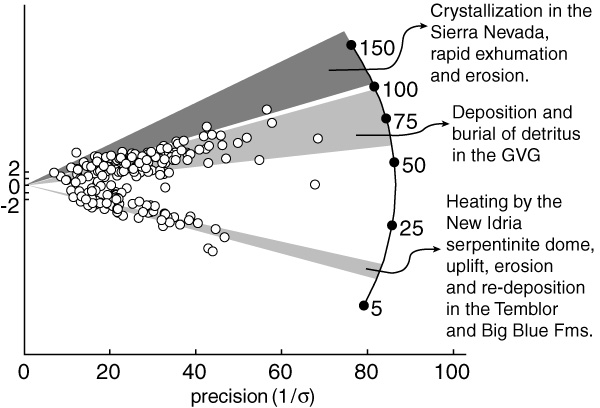


Next: ACKNOWLEDGEMENTS
Up: GSABpaper
Previous: IMPLICATIONS FOR THE CRETACEOUS
Figure:
The history of Joaquin Ridge sediments summarized on a single fission
track radial plot, compiled from all the apatite fission track data.
 |
Figure 7 summarizes the history of the Great Valley Group
near Coalinga and New Idria:
- The U/Pb, zircon and apatite fission track ages of unreset
apatite and zircon show that the southern Sierra Nevada underwent
rapid and steady exhumation during the Late Cretaceous. As the
exhuming mountain range was eroded, it shed sediments in the Great
Valley forearc basin. These sediments are presently exposed in a
homocline on the eastern flank of the Diablo Range.
- The Great Valley Group turbidites were buried to great depths,
but under refrigerated thermal gradients, produced by Franciscan
subduction (Dumitru, 1988).
- During the Middle to Late Miocene (
 12-14 Ma), the
Mendocino triple junction migrated from south to north to the west of
Coalinga (Johnson and O'Neil, 1984). Its passage was associated with
minor igneous activity, dated at
12-14 Ma), the
Mendocino triple junction migrated from south to north to the west of
Coalinga (Johnson and O'Neil, 1984). Its passage was associated with
minor igneous activity, dated at  12.8 Ma (Obradovich et
al., 2000).
12.8 Ma (Obradovich et
al., 2000).
- The faulting and folding caused by the San Andreas fault
introduced fluids in the ophiolitic crust that underlies the Great
Valley Group. These fluids reacted with the peridotitic rocks and
formed serpentine minerals. Because of its low density and the
relative ease with which it deformed, the serpentinite body rose
rapidly. The combined effect of the folding and the rise of the
serpentinite diapir caused substantial uplift of Joaquin Ridge, and
secondary folding and faulting in the adjacent Vallecitos Syncline
(Rentschler, 1985). Paleocurrent directions reversed, and
re-sedimentation of Great Valley Group detritus formed the Middle
Miocene Temblor and younger formations. The Big Blue came to the
surface as a rising hot protrusion, heating the Great Valley Group on
the way up and spreading at once over the countryside.
- Because it formed at great depth or because the serpentinization
reactions are exothermic, the New Idria serpentinite body was hot
when it approached the surface, forming a thermal halo. The heating
was sufficient to completely anneal apatites in the surrounding
country rock and explain the relatively high vitrinite reflectance
values that are observed near the contact between the Great Valley
Group and the serpentinite body.
- The heat released by the serpentinite produced diagenetic
alteration of cristobalitic to quartzose silica in the Moreno Shale,
which underlies the Vallecitos syncline (Murata et al., 1979),
pushing the source rocks of this basin into the thermal oil window.
- Alternatively, it is possible that syenitic intrusions in the
serpentinite body provided the ``missing'' heat source. However, we
think that the serpentinite body itself is a more realistic
alternative because it is size rather than temperature that
determines the amount of time it takes for a hot body to cool, and
the size of the resulting thermal halo. A small igneous intrusion may
have been hotter than the serpentinite protrusion, but it would not
be felt as long, and as far into the country rock.
- Deformation and folding continue in the Joaquin Ridge area
today, witnessed by the 1983 Coalinga earthquake. However, gravity
data suggesting that the root of the New Idria body is only a few
kilometers deep, imply that the exhumation of the serpentinite diapir
has almost stopped (Byerly, 1966; Casey and Dickinson, 1976).



Next: ACKNOWLEDGEMENTS
Up: GSABpaper
Previous: IMPLICATIONS FOR THE CRETACEOUS
Pieter Vermeesch
2005-05-03

